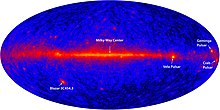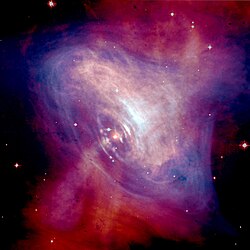| Observation data Epoch J2000 Equinox J2000 | |
|---|---|
| Constellation | Taurus |
| Right ascension | 05h 34m 31.95s[2] |
| Declination | +22° 00′ 52.2″[2] |
| Apparent magnitude (V) | 16.65[3] |
| Characteristics | |
| Evolutionary stage | Neutron star |
| U−B color index | −0.45[citation needed] |
| B−V color index | +0.47[4] |
| Astrometry | |
| Proper motion (μ) | RA: −11.34 ± 0.06[5] mas/yr Dec.: 2.65 ± 0.14[5] mas/yr |
| Parallax (π) | 0.53 ± 0.06 mas[5] |
| Distance | approx. 6,200 ly (approx. 1,900 pc) |
| Details | |
| Radius | 10[citation needed] km |
| Luminosity | 0.9 L☉ |
| Temperature | center (modeled): ~3×108[6] K, surface: ~1.6×106 K |
| Rotation | 33.5028583 ms[7] |
| Age | 8,142[citation needed] years |
| Other designations | |
| Database references | |
| SIMBAD | data |
The Crab Pulsar (PSR B0531+21 or Baade's Star) is a relatively young neutron star. The star is the central star in the Crab Nebula, a remnant of the supernova SN 1054, which was widely observed on Earth in the year 1054.[8][9][10] Discovered in 1968, the pulsar was the first to be connected with a supernova remnant.[11]

The Crab Pulsar is one of very few pulsars to be identified optically. The optical pulsar is roughly 20 kilometres (12 mi) in diameter and has a rotational period of about 33 milliseconds, that is, the pulsar "beams" perform about 30 revolutions per second.[6] The outflowing relativistic wind from the neutron star generates synchrotron emission, which produces the bulk of the emission from the nebula, seen from radio waves through to gamma rays. The most dynamic feature in the inner part of the nebula is the point where the pulsar's equatorial wind slams into the surrounding nebula, forming a termination shock. The shape and position of this feature shifts rapidly, with the equatorial wind appearing as a series of wisp-like features that steepen, brighten, then fade as they move away from the pulsar into the main body of the nebula. The period of the pulsar's rotation is increasing by 38 nanoseconds per day due to the large amounts of energy carried away in the pulsar wind.[12]
The Crab Nebula is often used as a calibration source in X-ray astronomy. It is very bright in X-rays, and the flux density and spectrum are known to be constant, with the exception of the pulsar itself. The pulsar provides a strong periodic signal that is used to check the timing of the X-ray detectors. In X-ray astronomy, "crab" and "millicrab" are sometimes used as units of flux density. A millicrab corresponds to a flux density of about 2.4×10−11 erg s−1 cm−2 (2.4×10−14 W/m2) in the 2–10 keV X-ray band, for a "crab-like" X-ray spectrum, which is roughly power-law in photon energy: I ~ E−1.1.[citation needed] Very few X-ray sources ever exceed one crab in brightness.
Pulsed emission up to 1.5 TeV has been detected from the Crab pulsar.[13] The only other known pulsar with emission in this energy range is the Vela Pulsar at 20 TeV.[14]
- ^ "Space Movie Reveals Shocking Secrets of the Crab Pulsar" (Press release). NASA. 19 September 2002.
- ^ a b Vallenari, A.; et al. (Gaia collaboration) (2023). "Gaia Data Release 3. Summary of the content and survey properties". Astronomy and Astrophysics. 674: A1. arXiv:2208.00211. Bibcode:2023A&A...674A...1G. doi:10.1051/0004-6361/202243940. S2CID 244398875. Gaia DR3 record for this source at VizieR.
- ^ Optical Observations of Pulsars: the ESO Contribution (PDF), p. 22
- ^ Davidson, Kris (October 1987). "SPECTROPHOTOMETRY OF THE CRAB NEBULA AS A WHOLE". The Astrophysical Journal. 94 (4): 967.
- ^ a b c Lin, Rebecca; van Kerkwijk, Marten H.; Kirsten, Franz; Pen, Ue-Li; Deller, Adam T. (1 August 2023). "The Radio Parallax of the Crab Pulsar: A First VLBI Measurement Calibrated with Giant Pulses". The Astrophysical Journal. 952 (2): 161. arXiv:2306.01617. Bibcode:2023ApJ...952..161L. doi:10.3847/1538-4357/acdc98.
- ^ a b Becker, W.; Aschenbach, B. (1995), "ROSAT HRI Observations of the Crab Pulsar An Improved Temperature Upper Limit for PSR 0531+21", in Alpar, M. A.; Kızıloğlu, Ü.; van Paradijs, J. (eds.), The Lives of the Neutron Stars, vol. 450, Kluwer Academic, p. 47, arXiv:astro-ph/9503012, Bibcode:1995ASIC..450...47B, ISBN 978-0-7923-324-6-6
{{cite book}}:|work=ignored (help) - ^ ATNF Pulsar Catalogue database entry. See Manchester, R. N.; et al. (2005), "The Australia Telescope National Facility Pulsar Catalogue", Astronomical Journal, 129 (4): 1993–2006, arXiv:astro-ph/0412641, Bibcode:2005AJ....129.1993M, doi:10.1086/428488, S2CID 121038776
- ^ Supernova 1054 – Creation of the Crab Nebula.
- ^ Duyvendak, J. J. L. (1942), "Further Data Bearing on the Identification of the Crab Nebula with the Supernova of 1054 A.D. Part I. The Ancient Oriental Chronicles", Publications of the Astronomical Society of the Pacific, 54 (318): 91, Bibcode:1942PASP...54...91D, doi:10.1086/125409
Mayall, N. U.; Oort, Jan Hendrik (1942), "Further Data Bearing on the Identification of the Crab Nebula with the Supernova of 1054 A.D. Part II. The Astronomical Aspects", Publications of the Astronomical Society of the Pacific, 54 (318): 95, Bibcode:1942PASP...54...95M, doi:10.1086/125410 - ^ Brandt, K.; et al. (1983), "Ancient records and the Crab Nebula supernova", The Observatory, 103: 106, Bibcode:1983Obs...103..106B
- ^ Zeilik, Michael; Gregory, Stephen A. (1998), Introductory Astronomy & Astrophysics (4th ed.), Saunders College Publishing, p. 369, ISBN 978-0-03-006228-5
- ^ Supernovae, Neutron Stars & Pulsars.
- ^ The H.E.S.S. Collaboration; Aharonian, F.; Benkhali, F. Ait; Aschersleben, J.; Ashkar, H.; Backes, M.; Martins, V. Barbosa; Batzofin, R.; Becherini, Y.; Berge, D.; Bernlöhr, K.; Bi, B.; Böttcher, M.; Boisson, C.; Bolmont, J.; et al. (5 October 2023). "Discovery of a radiation component from the Vela pulsar reaching 20 teraelectronvolts". Nature Astronomy. 7 (11): 1341–1350. arXiv:2310.06181. doi:10.1038/s41550-023-02052-3. ISSN 2397-3366.
- ^ The H.E.S.S. Collaboration; Aharonian, F.; Benkhali, F. Ait; Aschersleben, J.; Ashkar, H.; Backes, M.; Martins, V. Barbosa; Batzofin, R.; Becherini, Y.; Berge, D.; Bernlöhr, K.; Bi, B.; Böttcher, M.; Boisson, C.; Bolmont, J. (5 October 2023). "Discovery of a radiation component from the Vela pulsar reaching 20 teraelectronvolts". Nature Astronomy. 7 (11): 1341–1350. arXiv:2310.06181. doi:10.1038/s41550-023-02052-3. ISSN 2397-3366.
